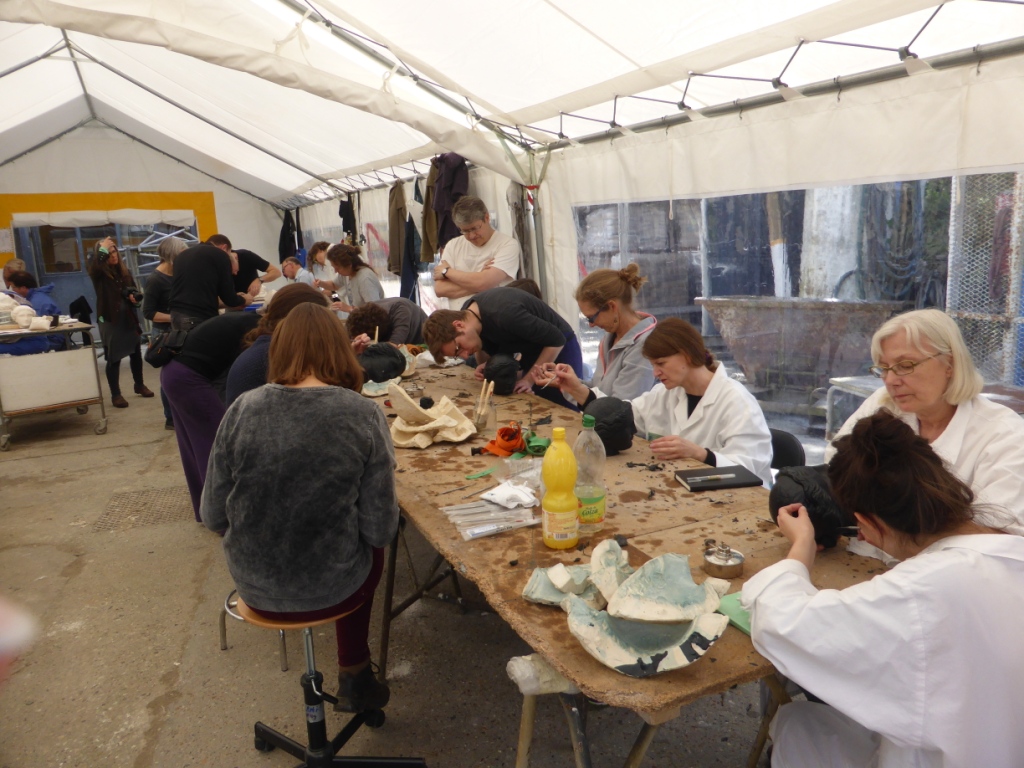
The meeting took place at the Coubertin Foundation near Paris on 4-8 July 2016. The preparation of the meeting is detailed on the following blog. Most details are reported in the following document (restricted access).
The Coubertin houses an active commercial art foundry that is known among other things for having cast the Iris and Gerald B. Cantor Collection’s Gates of Hell by Auguste Rodin in one piece, and for being the first foundry in France to have adopted the ceramic shell process for fine art casting (ref Dubos 2014). It is also the seat of specialized metalwork tradesman education – both foundry and wrought iron work (among other trades) -- so we will be in very good hands.
The two key objectives for this meeting were:
- to assess both the content and the working process on the CAST:ING Guidelines Volume 1, Chapter 2 thus far, and to discuss the next steps, and
- to experiment first-hand with several bronze casting processes. Such practical experience is invaluable for the technical study of bronzes, and will no doubt also help us resolve dilemmas we may have regarding vocabulary and content of the CAST:ING guidelines. Given the varied expertise and interests of our members, and time limitations, we propose to offer hands-on sessions on the following:
- sand casting of a hollow form (very popular process in France in the 1800s, for instance)
- lost wax casting using the slush molding technique (an indirect process used since antiquity and still prevalent today, see videos)
- lost wax casting using the lasagna technique (described by Benvenuto Cellini, see schemes in Bewer, F., and McNamara, M. 2012 - the pdf of this paper is downloadable from the CAST:ING Zotero shared bibliography)
- lost wax casting using wax sheets (as found, for instance, in large ancient South Arabian bronzes, and Thai sculptures among others, see videos)
The first two of the listed options have provided a good basic understanding of widely-used techniques. The latter two options are more specialized attempts at reconstructing specific historical processes.
Each participanthad the opportunity to explore 1 or 2 out of the 4 techniques through a group production of hollow bronze heads (based on an ancient model). In addition, participants were able to practice cold working (fettling and chasing).
The outline of the program is provided below.
Schedule
DIMANCHE 3 juillet
Soir : registration opens at 5 pm, dinner served at 7pm
. Welcome at 8pm by François Jourdan, Directeur Général de la Fondation de Coubertin and Christophe Béry, Directeur de la Fonderie de Coubertin
. Overview of the program of the meeting by David Bourgarit (see powerpoint):
Experimental activities:
-
recreation of the head of an ancient bronze statue using four different techniques to achieve the hollow mold
-
CASTING
-
cold working
-
Patination
Discussion sessions:
-
Related to the experimental activities and how questions and insights might feed into content/vocabulary of Guidelines
-
Assessing the content and the working process of the CAST:ING Guidelines Volume 1, Chapter 2, and discussion of the next steps
LUNDI 4 juillet
Matin: 1st rotation of 4 hands-on experimentation groups (one for each process)
LOST-WAX (LW): 1st rotation of 3 hands-on experimentation groups for those having chosen lost-wax processes (one for each process),
SAND-CASTING (SC): Beginning of sand casting for the others
Après-midi :
LW: Continue the morning’s work till the end of the molding process (molds ready for baking),
SC: Continue the morning’s work
Soir : Overview of the current state of the CAST:ING project including writing, website and publication (see powerpoint)
MARDI 5 juillet
Matin:
LW: 2nd rotation,
SC: Continue the Monday’s work
Après-midi :
LW: Continue the morning’s work till the end of the molding process, all molds (1st & 2nd round) are baked during the night and following day (≈28 hours)
SC: Continue the morning’s work till the end of the molding process, molds ready for casting on Wednesday morning.
Soir: 15 min presentations on on-going programs on bronze sculptures by young researchers (see powerpoint):
• Aurélia Azéma: La soudure par fusion au bronze liquide : étude expérimentale des techniqes d'assemblages dans la grande statuaire antique en bronze / The flow fusion welding process: an experimental study of the joining techniques used on the Classical Antiquity large bronze statues
• Mathilde Mechling: Sculptures en bronze d'Indonésie (7e-11e siècle) / Bronze sculptures from Indonesia (7th-11th century)
• Lise Saussus: Le cuivre et ses alliages dans les Flandres médiévales. Autour d'un atelier à Douai (13e-15e siècles) / Copper alloys in medieval Flanders regarding a workshop in Douai (13th-15th centuries)
• Manon Castelle: Bronzes Français aux XVIe-XVIIe siècles: développements méthodologiques et résultats récents sur l'étude des noyaux / French bronze statuary from the 16th-17th c.: methodological developments and recent results of the study of casting cores
• Emmanuel Lamouche: Les fondeurs à Rome aux XVIe et XVIIe siècles / Bronze founders in Rome, 16th-17th centuries
MERCREDI 6 juillet :
Matin:
LW: general presentation of the CAST:ING project and working groups, and 3 working groups: nuts and bolts (BOX, Zotero, etc.), assemblies, repairs
SC: Casting of sand casting molds, breaking bronzes out of mold, and beginning of fettling
Après-midi :
LW: working group on inlays and overlays, and general discussion
SC: fettling & chiseling
Soir : "Une Odyssée", by the Compagnie les Gauchers
JEUDI 7 juillet :
Matin:
LW: Casting of sand casting molds, breaking bronzes out of mold, and beginning of fettling
SC: general presentation of the CAST:ING project and working groups, and 4 working groups: casting features, defects, toolmarks, patina
Après-midi :
LW: fettling & chiseling
SC: working group on nuts and bolts (BOX, Zotero, etc.)
Soir: Presentation of CAST:ING meeting #3 in Cambodia (see powerpoint)
VENDREDI 8 juillet :
Matin:
LW&SC: fettling & chiseling
Après-midi :
LW&SC: short demonstration on patina, farewell coktail at the fonderie, and presentation of conclusions and prospects (see powerpoint)
Soir: free
SAMEDI 9 juillet:
Matin: Fond farewells
SELECTION of PHOTOS (photos C2RMF, V Fournier or B Mille)
